比较和合并测试文件
此示例演示了如何使用比较工具比较并合并两个 MLDATX 测试文件。如果你有两个相同类型的测试,例如两个基线测试或两个等效性测试,你可以将这些测试用例合并到一个目标文件中。您不能合并不同测试类型的测试用例,但可以将它们作为单独的测试用例添加到目标文件中。
比较测试文件
打开比较工具。
visdiff("TestFile_1.mldatx","TestFile_2.mldatx")
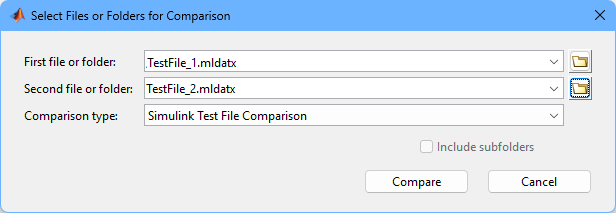
该工具使用以下颜色突出显示两个文件之间的差异:
紫色 - 两个文件的内容不同。
蓝色 - 内容仅存在于右侧窗格中的文件中。
黄色 - 内容仅存在于左侧窗格中的文件中。
没有亮点 - 两个文件的内容相同。
要生成比较报告,请选择发布 > 发布为 HTML、发布 > 发布为 Word 或发布 > 发布为 PDF。该图显示了报告的样本。
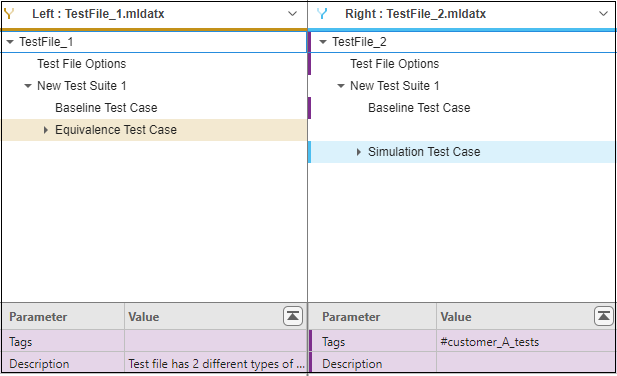
合并测试文件
1.如果比较工具未打开,请输入 visdiff("TestFile_1.mldatx","TestFile_2.mldatx")。
2.点击合并模式。目标文件窗格在两个文件窗格下方打开。比较工具使用右窗格文件中的内容填充目标文件。右侧窗格中的列包含目标文件中的每个节点或参数的一个、两个或不包含单选按钮。对于可以合并的节点,默认选择右窗格文件的单选按钮。
目标窗格使用以下颜色:
蓝色 - 选择了右侧窗格中的内容。
黄色 - 已选择左侧窗格中的内容。
没有亮点 - 两个文件的内容相同。
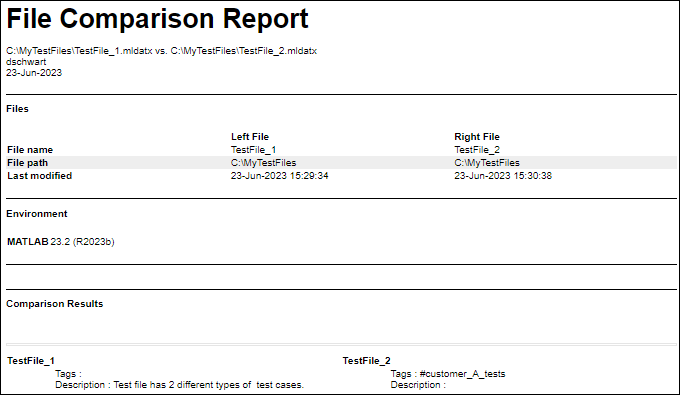
当您进入合并模式时,单选按钮指示您可以对想要合并的节点采取的操作:
无单选按钮 - 对于节点,当两个文件的内容相同时,则无法合并。对于参数,如果参数是只读的,则无法合并。
一个单选按钮 - 目标文件中的节点与单选按钮列所关联的文件中的节点相同。当另一个文件中的相应节点无效时,就会出现这种情况,因此您无法合并内容。
两个单选按钮且其中一个被选中 - 目标文件中的节点与选定单选按钮的列所关联的文件中的节点相同。根据内容的类型,选择另一个单选按钮可以添加节点内容或在目标文件中替换它。
3.选择要合并、添加或删除内容的文件列中的单选按钮。没有单选按钮的节点可能具有可合并的较低层次结构的节点。对于那些节点,选择上级节点可以查看其层次结构。
直到测试运行时才会评估合并节点和参数的有效性。
使用描述单选按钮来选择新测试文件要使用的描述。对于此示例,选择左侧单选按钮以使用左侧文件中的描述。
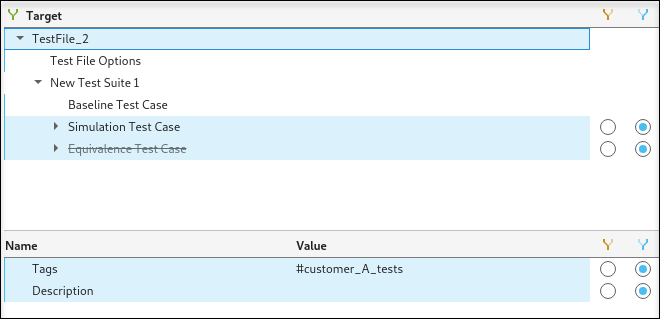
使用等效性测试用例单选按钮选择要添加到新测试文件的测试用例。对于此示例,选择左侧单选按钮以从左侧文件中添加等效性测试用例。

仿真测试用例只存在于正确的文件和目标文件中。要从目标文件中删除仿真测试用例,请选择左边的单选按钮。
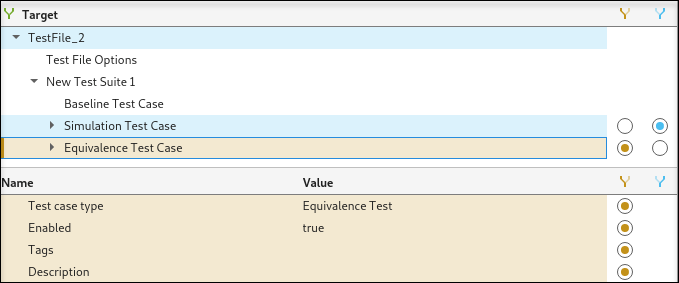
4.点击保存结果保存合并后的目标文件。指定 TestFile_merged.mldatx 作为文件名。保存文件后,合并模式关闭并返回比较模式。保存的目标文件成为新的右窗格文件。
5.要查看已保存的合并,请打开测试管理器。
sltest.testmanager.view
从“打开”下拉菜单中选择打开 > 打开 (.mldatx),然后打开 TestFile_merged.mldatx file。
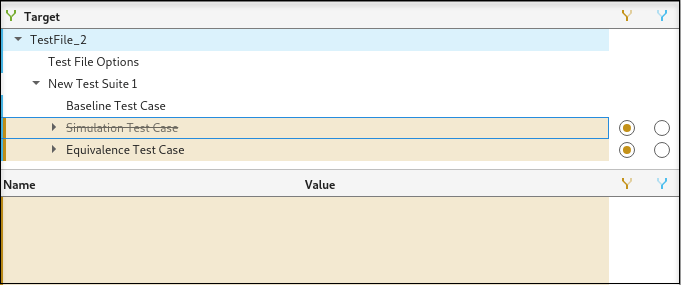
标签包含右窗格文件中的文本。描述包含左窗格文件中的文本。该文件包含等效性测试用例,不包含仿真测试用例。
文件合并限制
您不能合并:
不同测试类型的测试用例。
其他不兼容的测试文件,例如具有不同元数据的文件,即使文件内容相同。
附加到测试文件的文件中的文件或内容,例如输入文件、基线和等效性准则以及覆盖率过滤器。
目标文件创建时自动创建的参数,例如文件名、上次修改者、上次修改日期和发布信息。
链接的需求。
文本字段。您可以从左侧或右侧窗格中选择一个文本字段,但不能组合它们。
此外,合并还有以下限制:
添加或删除一个节点会分别添加或删除其所有子节点。
如果添加与目标文件中的测试用例,测试用例在添加的测试用例的名称后附加一个数字。
测试用例回调显示为名称-参量对。
相互依赖的设置(例如在测系统及其测试框架)一起更新。例如,如果您替换在测系统,使其使用来自其他文件的系统,则测试框架也会更改为使用与新的在测系统关联的框架。
虽然您可以在测试套件和测试用例级别更改要收集的覆盖率设置,但这些更改不会保存在目标文件中,除非它们与测试文件级别的设置相同。
保存合并文件时,必须在文件名中明确包含
.mldatx扩展名。当使用
mlAutomergeGit 插件自动合并测试文件时,将*.mldatx binary merge=mlAutomerge添加到.gitattributes文件中。有关使用mlAutomerge的信息,请参阅 Automatically Merge Models Locally and in CI Pipeline。